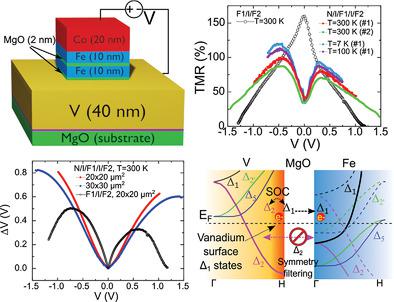当前位置:
X-MOL 学术
›
Adv. Electron. Mater.
›
论文详情
Our official English website, www.x-mol.net, welcomes your
feedback! (Note: you will need to create a separate account there.)
Boosting Room Temperature Tunnel Magnetoresistance in Hybrid Magnetic Tunnel Junctions Under Electric Bias
Advanced Electronic Materials ( IF 5.3 ) Pub Date : 2021-10-22 , DOI: 10.1002/aelm.202100805 César González‐Ruano 1 , Coriolan Tiusan 2, 3, 4 , Michel Hehn 4 , Farkhad G. Aliev 1
Advanced Electronic Materials ( IF 5.3 ) Pub Date : 2021-10-22 , DOI: 10.1002/aelm.202100805 César González‐Ruano 1 , Coriolan Tiusan 2, 3, 4 , Michel Hehn 4 , Farkhad G. Aliev 1
Affiliation

|
Spin-resolved electron symmetry filtering is a key mechanism behind giant tunneling magnetoresistance (TMR) in Fe/MgO/Fe and similar magnetic tunnel junctions (MTJs), providing room temperature functionality in spin electronics. However, the electron symmetry filtering breaks down under applied bias, dramatically reducing the TMR above 0.5 V. This strongly hampers the application range of MTJs. To circumvent the problem, resonant tunneling through quantum well states in thin layers has been used so far. This mechanism, however, is mainly effective at low temperatures. Here, a fundamentally different approach is demonstrated, providing a strong TMR boost under applied bias in V/MgO/Fe/MgO/Fe/Co hybrids. This pathway uses spin orbit coupling (SOC) controlled interfacial states in vanadium, which contrary to the V(001) bulk states are allowed to tunnel to Fe(001) at low biases. The experimentally observed strong increase of TMR with bias is modeled using two nonlinear resistances in series, with the low bias conductance of the first (V/MgO/Fe) element being boosted by the SOC-controlled interfacial states, while the conductance of the second (Fe/MgO/Fe) junctions are controlled by the relative alignment of the ferromagnetic layers. These results pave a way to unexplored and fundamentally different spintronic device schemes, with tunneling magnetoresistance uplifted under applied electric bias.
中文翻译:

在电偏置下提高混合磁隧道结中的室温隧道磁阻
自旋分辨电子对称滤波是 Fe/MgO/Fe 和类似磁隧道结 (MTJ) 中巨隧道磁阻 (TMR) 背后的关键机制,在自旋电子学中提供室温功能。然而,电子对称滤波在施加的偏压下会失效,从而将 TMR 显着降低到 0.5 V 以上。这极大地阻碍了 MTJ 的应用范围。为了规避这个问题,迄今为止已经使用了通过薄层中的量子阱状态的谐振隧穿。然而,这种机制主要在低温下有效。在这里,展示了一种根本不同的方法,在 V/MgO/Fe/MgO/Fe/Co 杂化物中施加的偏压下提供了强大的 TMR 提升。该途径在钒中使用自旋轨道耦合 (SOC) 控制的界面态,与 V(001)体态相反,允许在低偏置下隧穿到 Fe(001)。实验观察到的 TMR 随偏置的强烈增加是使用两个串联的非线性电阻建模的,第一个 (V/MgO/Fe) 元素的低偏置电导由 SOC 控制的界面态提高,而第二个元素的电导(Fe/MgO/Fe) 结由铁磁层的相对排列控制。这些结果为未探索和根本不同的自旋电子器件方案铺平了道路,在施加的电偏压下隧道磁阻升高。第一个 (V/MgO/Fe) 元素的低偏置电导由 SOC 控制的界面态提高,而第二个 (Fe/MgO/Fe) 结的电导由铁磁层的相对排列控制. 这些结果为未探索和根本不同的自旋电子器件方案铺平了道路,在施加的电偏压下隧道磁阻升高。第一个 (V/MgO/Fe) 元素的低偏置电导由 SOC 控制的界面态提高,而第二个 (Fe/MgO/Fe) 结的电导由铁磁层的相对排列控制. 这些结果为未探索和根本不同的自旋电子器件方案铺平了道路,在施加的电偏压下隧道磁阻升高。
更新日期:2021-10-22
中文翻译:

在电偏置下提高混合磁隧道结中的室温隧道磁阻
自旋分辨电子对称滤波是 Fe/MgO/Fe 和类似磁隧道结 (MTJ) 中巨隧道磁阻 (TMR) 背后的关键机制,在自旋电子学中提供室温功能。然而,电子对称滤波在施加的偏压下会失效,从而将 TMR 显着降低到 0.5 V 以上。这极大地阻碍了 MTJ 的应用范围。为了规避这个问题,迄今为止已经使用了通过薄层中的量子阱状态的谐振隧穿。然而,这种机制主要在低温下有效。在这里,展示了一种根本不同的方法,在 V/MgO/Fe/MgO/Fe/Co 杂化物中施加的偏压下提供了强大的 TMR 提升。该途径在钒中使用自旋轨道耦合 (SOC) 控制的界面态,与 V(001)体态相反,允许在低偏置下隧穿到 Fe(001)。实验观察到的 TMR 随偏置的强烈增加是使用两个串联的非线性电阻建模的,第一个 (V/MgO/Fe) 元素的低偏置电导由 SOC 控制的界面态提高,而第二个元素的电导(Fe/MgO/Fe) 结由铁磁层的相对排列控制。这些结果为未探索和根本不同的自旋电子器件方案铺平了道路,在施加的电偏压下隧道磁阻升高。第一个 (V/MgO/Fe) 元素的低偏置电导由 SOC 控制的界面态提高,而第二个 (Fe/MgO/Fe) 结的电导由铁磁层的相对排列控制. 这些结果为未探索和根本不同的自旋电子器件方案铺平了道路,在施加的电偏压下隧道磁阻升高。第一个 (V/MgO/Fe) 元素的低偏置电导由 SOC 控制的界面态提高,而第二个 (Fe/MgO/Fe) 结的电导由铁磁层的相对排列控制. 这些结果为未探索和根本不同的自旋电子器件方案铺平了道路,在施加的电偏压下隧道磁阻升高。











































 京公网安备 11010802027423号
京公网安备 11010802027423号